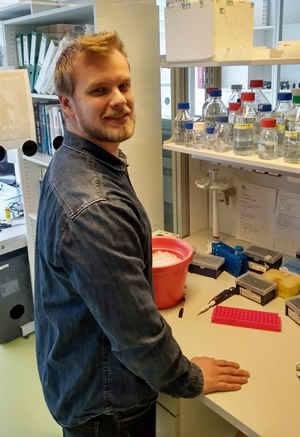Simon Hoserby Matthew Rollins  Simon Hoser is a third-year PhD student at The Medical University Innsbruck in Austria, where he studies the regulation of splicing by mitochondrial tRNA in the lab of Dr. Alexander Hüttenhofer. Growing up in Innsbruck, Austria, Simon also received his Bachelor’s degree in Biology at Leopold Franzens University in Innsbruck. Simon didn’t arrive at the graduate school as a PhD student, though. He entered as a Master’s student, but after taking practical coursework in ribozyme reactions, radioactive labeling, and SNP analysis, he was hooked. Simon recalled, “the impressive knowledge and competence of a graduate student who was tutoring the course awoke my interest.” Simon then joined the Hüttenhofer lab to work on a non-coding RNA that turned out later to be involved in splicing. He said, “I think that’s the point when I caught fire since I was doing something that nobody was an expert in our lab.” This research experience led to Simon’s enrollment in the PhD program. “After finishing my master’s, my PI asked me if I wanted to continue the project for a PhD. At that point, I didn’t want to let the project go.” Simon explained that his PhD program is different from US and other European programs. “Here, you can only enroll in a PhD program if you already have a supervisor. Depending on the supervisor and the student, PhD theses can take from 3 up to 10 years. We are supposed to publish at least one paper during our thesis depending on the program. In addition, at least 90% to the PhD consists of working on your project, thus class work and studying is on the side.” Simon’s transition to PhD candidacy meant he had to give up another passion: American football. Before his PhD program, Simon spent four years playing semi-professional American football in Innsbruck for the Tyrol Raiders. After winning a CEFL and 3 Austrian championships, the demands of research meant stepping off the gridiron in 2018 and tackling lab work and his thesis. Simon still stays active and has transitioned to weightlifting while pursuing his PhD. The younglings of today are the PIs of tomorrow. The students are more open-minded in some aspects. Everyone I met in RNA Society Junior’s team is highly motivated young scientists, so I think as long as the RNA Society can continue to include students, the future is bright. Simon’s novel discovery of the mitochondrial tRNA regulating splicing has been rewarding, but Simon also feels fortunate for having a group of friendly colleagues. “Being a small lab, we value having lunch together, often resulting in vivid conversations on our respective projects,” he said. “We get along very well professionally and personally, which makes a hard day in the lab more bearable and even fun.” It is that spirit of teamwork and engagement that drives Simon’s scientific pursuits. He continued, “In science, the problem-solving part interests me most. One has to deal with one’s own failure and ask questions. I find it especially inspiring and satisfying having intense talks with people who are coming from different fields, because this helps me to broaden my vision and start asking questions. I also love the fact that scientists you talk to think deeply about what you are saying. Science demands an open discourse that I find highly invigorating.” Simon’s enthusiasm for research also extends into the RNA community. Simon wants that invigorating sense of community to grow; now part of the RNA Junior Scientists committee, he continues to push for student development and mentorship. “The younglings of today are the PIs of tomorrow. The students are more open-minded in some aspects. Everyone I met until now is highly motivated young scientists, so I think as long as the RNA Society can continue to include students, the future is bright.” As an active member of the RNA society, Simon recalled last year’s RNA Meeting, “I went to my first meeting in Krakow by myself and knew absolutely nobody there. The first thing I did was say hi to a group of junior scientists I saw outside of the event location. It was about 35°C outside, so I said, ‘Nice weather for a congress, right?’ Five minutes later I was eating in an original polish pierogi place with a group of people I just met.” He reflected, “This is what science is to me: It doesn’t matter who you are, people are open-minded.”
Simon currently contributes to the Junior RNA Twitter @jrRNAscientists, and he can be found on his personal Twitter (@GenieofGenes) where he discusses genes and memes. His favorite RNA is the tRNA, and he considers Charles Darwin an inspiration. “I was always fascinated by the diversity of life and the theory of evolution. After watching Jurassic Park, I wanted to clone my own dinosaurs (work in progress).” |
